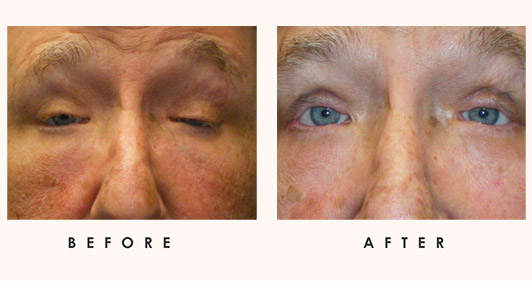BLEPHARITIS, ALLERGIC CONJUNCTIVITIS
Jump To
VIRAL VS. BACTERIAL INFECTIONS
A virus consists of a core of nucleic acid (DNA or RNA) surrounded by a coat of antigenic protein. The virus provides the genetic code for replication, whereas the host cell provides the energy and raw material for the virus to grow. This is different than a bacteria, which are single cell organisms that do not have a nucleus and are among the most simple and most abundant life forms on earth. Antibiotics are effective against bacterial infections, not viruses. Bacteria grow outside the host cell and can be attacked by antibiotics.
Blepharitis
Blepharitis is a common and sometimes chronic condition that causes inflammation of the eyelids. It usually affects both eyes along the edges of the eyelids and typically occurs when the oil glands near the base of the eyelashes become clogged, often causing redness/irritation. Several diseases and conditions can cause blepharitis. It can be difficult to treat, and although uncomfortable and unsightly, does not usually cause permanent damage to your eyesight. It is not contagious.
Blepharitis occurs in two forms: anterior blepharitis and posterior blepharitis.
Anterior blepharitis affects the outside front of the eyelid, where the eyelashes are attached. The two most common causes of anterior blepharitis include bacteria (staphylococcus) and scalp dandruff. Posterior blepharitis also impacts the inner eyelid (the moist part that makes contact with the eye) caused by problems with the oil (meibomian) glands in this part of the eyelid. The two skin disorders can cause this form of blepharitis include acne rosacea, which leads to red and inflamed skin, and scalp dandruff.
Chalazion, a painless firm lump caused by inflammation of the oil glands of the eyelid, is a condition that is sometimes associated with blepharitis.
SYMPTOMS OF BLEPHARITIS
- dry eye
- foreign body
- burning sensation
- excessive tearing
- itching
- sensitivity to light (photophobia)
- red and swollen eyelids,
- redness of the eye
- crusting of the eyelashes on awakening
TREATMENT OF BLEPHARITIS
At Idaho Eyelid and Facial Plastic Surgery, treatment will involve our patients keeping the eyelids clean and free of crusts. Warm compresses can loosen the crusts, followed by a light scrubbing of the eyelid with a cotton swab and a mixture of water and baby shampoo. Patients who also have acne rosacea should have that condition treated at the same time.
Allergic Conjuctivitis
Allergic conjunctivitis is the irritation of the conjunctiva, or covering of the eyeball, as a reaction to an allergic substance to which one is sensitive. Allergic conjunctivitis, which is not contagious, causes one’s eyes to become watery, red, swollen, itchy, and often painful. This condition, which is may also be called allergy eyes, may be acute or chronic over a period of time.
There are two types of allergic conjunctivitis: seasonal and perennial. Seasonal allergic conjunctivitis affects people during specific seasons of the year while perennial allergic conjunctivitis impacts people throughout the year. Allergic conjunctivitis can cause much discomfort due to the symptoms listed above. In adds to, untreated allergic conjunctivitis can result in eye rubbing, which could lead to permanent eye damage.
CAUSES OF ALLERGIC CONJUNCTIVITIS
A person develops the condition when exposed to an allergic or sensitive substance, which is referred to as an allergen. Allergens are the most common cause of allergic conjunctivitis. Many of these allergens are listed below:
- Pollen. Trees, grass, weeds, and flowers release the allergen pollen into the air. During the spring and fall months, pollen levels are at their highest. Pollen affects those with allergic conjunctivitis by entering the throats and noses of those who are sensitive to the substance. Pollen levels are at the highest during the spring and fall months. Pollen is considered one of the hardest causes of allergic conjunctivitis to control. Some common types of pollen include, ragweed, cedar and ash.
- Mold. Allergen mold is also released through the air, from spores in leaves, grass, and hay. Mold usually impacts those who are susceptible between spring and late fall. Cold temperatures and snow diminish the mold spores count, yet they are still present after frost begins. Mold can also develop in damp atmospheres within the home, such as the kitchen or bathroom.
- Pets. A dog or cat’s dander, or skin flakes, as well as its saliva and urine can be powerful allergens. Although the actual hair of a pet is not considered a powerful allergen itself, the pet’s hair or fur can collect mold, pollen, and dust.
- Dust mites. Tiny bugs that are related to spiders and ticks, also cause allergic conjunctivitis. Cleanliness, moisture levels, among other factors have impact on the amount of dust mites that might possibly be found in your home. Dust mites can be found on the sofas, curtains, bed sheets, and other such places within the home. By commonly vacuuming and washing bed sheets one can reduce the number of dust mites in the home.
- Pollution. Pollution is commonly associated with allergic conjunctivitis. While it comes in various forms, air pollution, such as the type released from automobiles and factories, is commonly one of the more powerful types of contamination linked to allergic conjunctivitis.
- Other. Some chemicals found in certain cosmetics, carpeting, and paint along with cigarette smoke are also thought to be allergens.
For those who suffer from allergy eyes, it is extremely important to identify the causes of allergic conjunctivitis. A person has a considerably better chance of controlling the condition and avoiding its unpleasant side effects once he or she is aware of the causes of allergic conjunctivitis.
Allergens are triggers or instigators of allergic reactions. Allergy eyes could be caused by one or several allergens. Thus, various people might possibly have to avoid more than one specific allergen in order to prevent allergy eyes. Although there are a large number of allergens, there are certain types that occur more prevalently with the condition than others.



